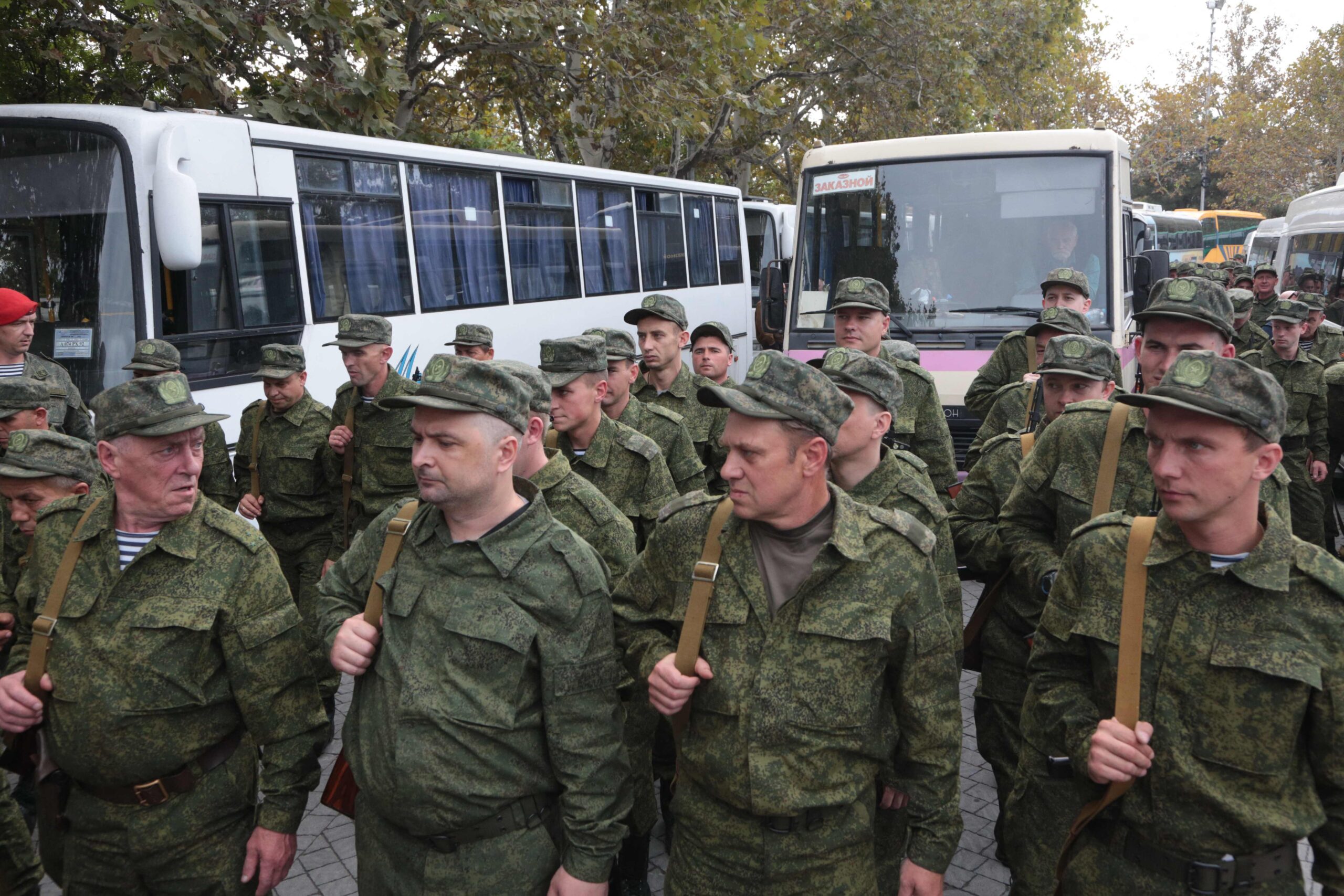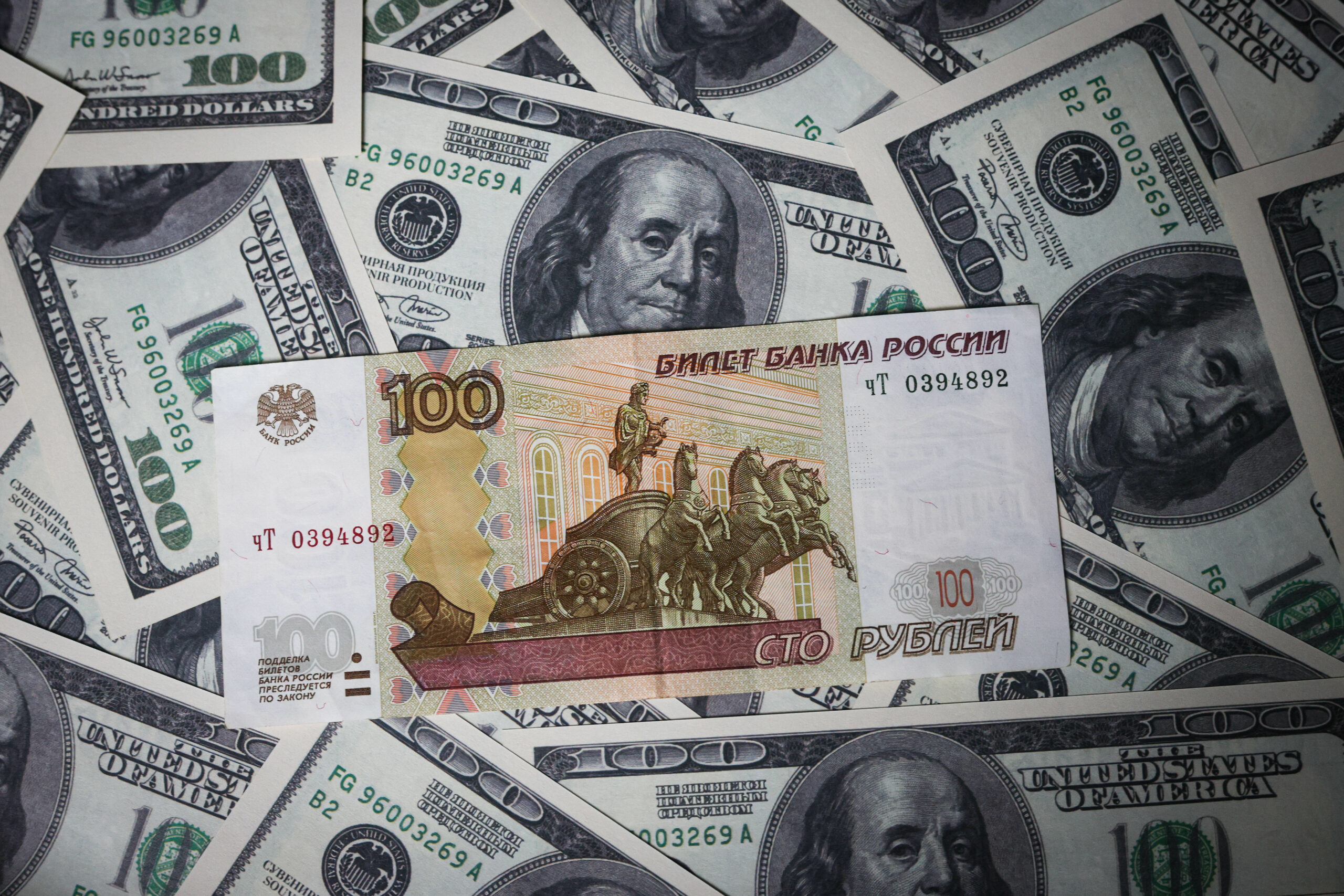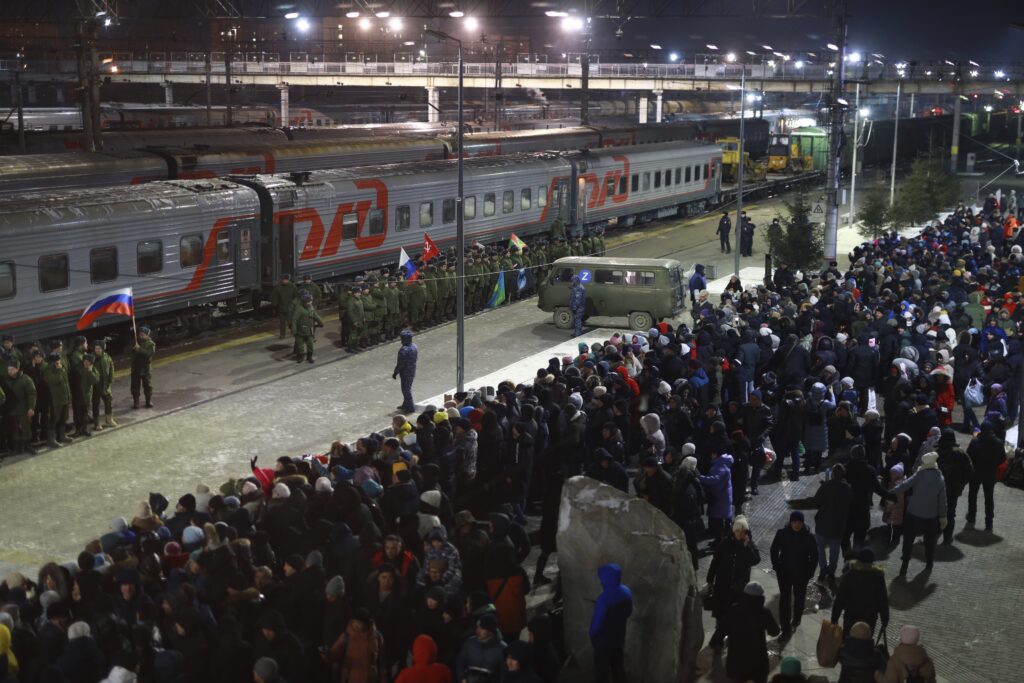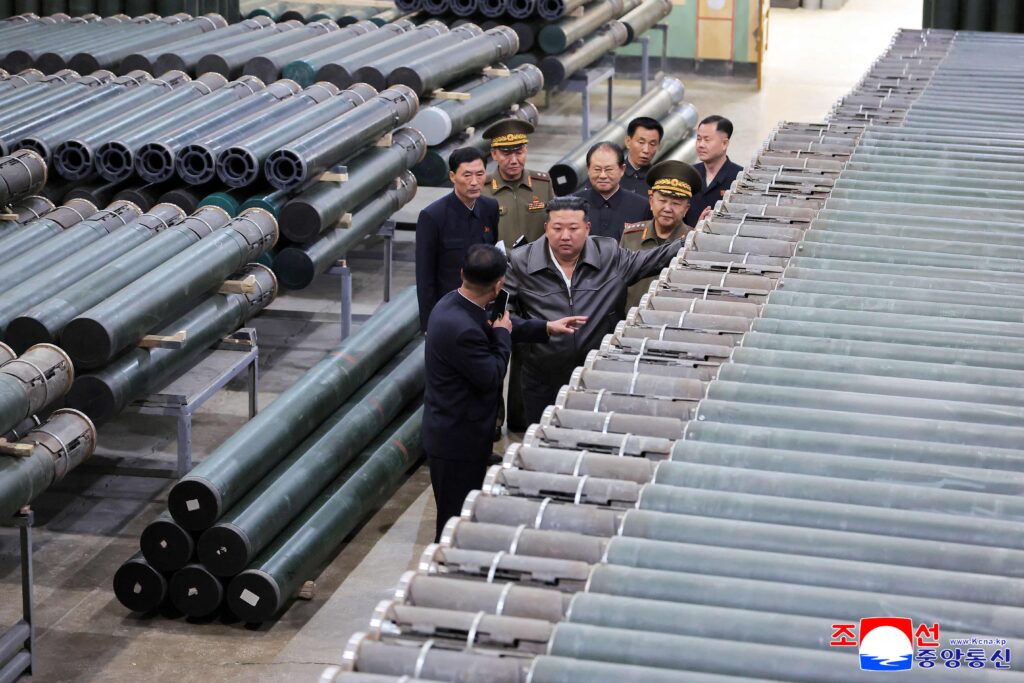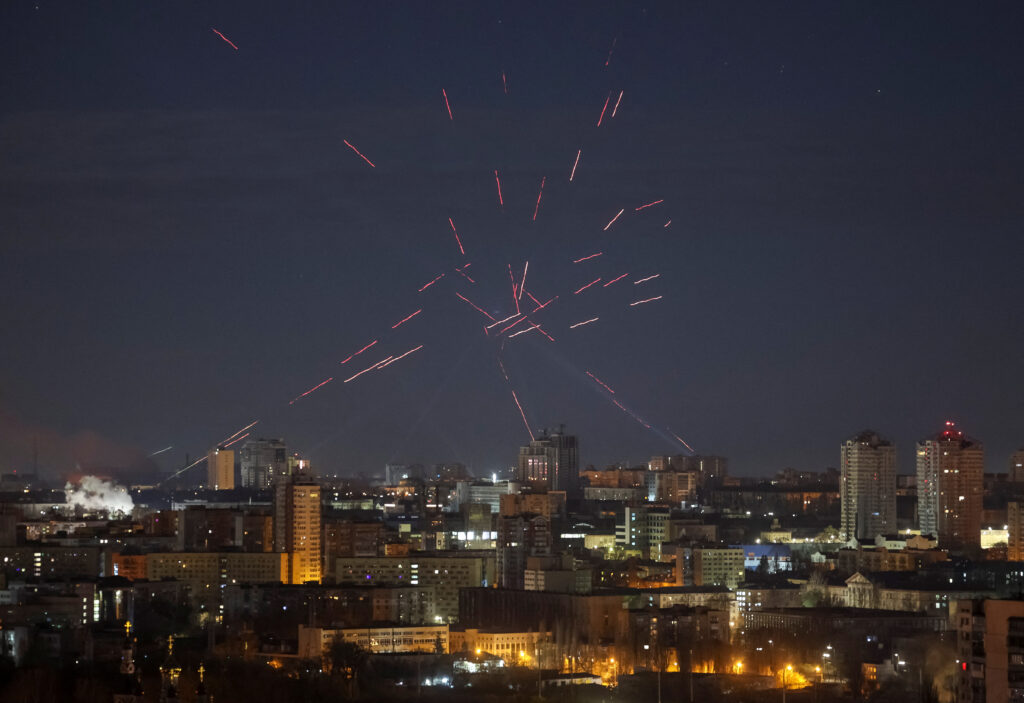The interim results of the «partial» mobilization confirm the apprehensions of an article published on Riddle back in August: it is almost impossible today to rapidly replenish the manpower of the Russian army after eight months of war. Some of the mobilized are sent to die on the battlefield without any preparation. The other part is officially at training grounds or centers, but the duration of their training is from 5 to 15 days, after which many are immediately sent into combat units.
Such a short period of time suggests the Russian army on the battlefield is in a fraught situation and is losing organizational integrity and combat effectiveness. The high losses and accumulated fatigue of the remaining units cannot be compensated qualitatively, so Moscow is trying to rely on at least their quantitative replenishment.
By the time the invasion began, the Russian Armed Forces had 168 battalion tactical groups (BTG) of constant readiness, each numbering 800−1000 people, i.e. with a total number of 134.5−168 thousand people. They were supplemented by parts of the Russian Guard, as well as mercenary groups and troops from the so-called «DNR/LNR». That all came to around 190 thousand people.
By mid-August, the Minister of Defense of Ukraine estimated the number of Russian troops at the front at 105 out of 115 BTGs, taking into account the introduced reserves ⸺ with a total number of up to 135 thousand people. Moreover, we are already talking about all official and unofficial armed formations, and not just about the RF Armed Forces. Probably, by the second half of September and in the conditions of the beginning of the offensive of the Armed Forces of Ukraine, the Russian army, as a regular military force, degraded even more.
Moscow’s approach to training its new mobilized personnel fundamentally does not allow for the restoration of knowledge and skills — even among those who once did military service. For those mobilized without experience, it is not even a question. Worse still, there is still no adequate supply of clothes and food to the mobilized, nor is there a provision of adequate living and sanitary conditions. Similarly tenuous is the payment of their promised monetary allowance.
As part of the mobilization, according to Putin, the Kremlin has recruited 222,000 people. Yet from the same speech, Putin cast doubt on his own estimations. He implied that the Kremlin had recruited a total of 271,000 by detailing that 222,000 people are allegedly in some kind of «formation troops» (a previously unknown term), plus 33,000 in military units, apparently withdrawn from the battlefield for resupply, and 16,000 directly on the battlefield. Were these instead just part of the 222,000? Apparently, this was a slip of the tongue, or the Russian president himself got confused by the available numbers.
At the same time, the mobilization with its announced but not published plan for 300,000 people should, according to Putin, be completed by the end of October. That said, the Kremlin immediately made a reservation that no decision was made to end this process, especially in those regions where the mobilization plan has stalled. Besides, on November 1 the autumn draft starts, shifted a month ahead due to mobilization; it is set to involve the recruitment of another 120,000 people for military service. In some regions, some officials meanwhile have begun curtailing mobilization activities, claiming to have already met quotas.
If we take the statisitical claims on those mobilized on faith, then in a couple of weeks the size of the warring Russian army should exceed the size of the original invasion group of 190 thousand people. The latter consisted not only of military personnel of the Armed Forces, but also of the military personnel of the National Guard and other paramilitary formations, including mercenaries. However, if these figures are questioned, then this whole idea of mobilization, which is already a social, political and economic disaster for Russia, has serious signs of failure.
Putin’s calculator
The confusing nature of the Kremlin’s mobilization figures becomes even more controversial when you look at the total strength of the armed forces. The maximum authorized strength of the RF Armed Forces today is 1.014 million people, and from January 1, 2023 it will be increased to 1.150 million, i.e. an increase of 137 thousand.
Those figures are unhelpful; sit is not clear how the Russian armed forces can return to the quantitative state of the turn of the 1990s-2000s, when the demographic situation in Russia was radically different. Nor is it clear how there will be a sufficient provision of the RF Armed Forces with salaries, equipment and weapons.
The real number on the eve of the invasion was, of course, much lower: 740−760 thousand people. Taking into account the losses incurred and the natural outflow of military personnel from the army, including due to a shortage of about 45 thousand people for the spring conscription, in August I predicted that by the end of 2022 the actual number of the Armed Forces, under unchanged conditions, would decrease to about 600 thousand.
At the same time, I pointed out that extra mobilization can lead to difficult-to-predict internal political consequences. Nor would it seriously compensate for losses in manpower. Besides the training shortfall, Russian society is largely unwilling to make huge sacrifices in blood and treasure for the Kremlin’s imperial ambition in Ukraine. And there are systemic reasons to cap it off: Russia does not have an appropriate institutional and material basisto rapidly mobilise.
The declared 300,000 mobilized citizens by the end of October and the planned 120,000 new conscripts should mean an added 420,000 military personnel by the end of 2022, when the maximum strength of the RF Armed Forces remains at 1.013 million people. At the same time, the actual number of armed forces cannot reach 100% of the maximum. Normal is the situation when 7−10% of military posts are not staffed. Therefore, if we accept the declared figures of those mobilized on faith, the current strength of the RF Armed Forces today hardly exceeds 500,000 people. Otherwise, it is simply impossible to increase it by the planned 420 thousand, with a staffing of 1.013 million. This means that the Russian figures for losses in killed, wounded, missing and captured, along with retired soldiers who have not been replaced, are approaching a quarter of a million people.
Estimates of the losses of Russian heterogeneous forces (not only the RF Armed Forces) killed, wounded and missing from the British military and Russian insiders today exceed 90 thousand people. Taking into account the outflow from the army of tens of thousands of people (the order of numbers is conjectural), it is impossible to reach a quarter of a million. Even if we start from the Ukrainian data, according to which the number of only killed and died from wounds exceeded 65 thousand people ⸺ the reduction of the armed forces by 250 thousand people also fails. This means that the minimum possible number of Russian Armed Forces today is in the range of 600−630 thousand people. Therefore, the declared 300,000 mobilized by the beginning of November and 120,000 planned draftees in November-December mean that the maximum strength of the RF Armed Forces has been exceeded. And this, once again, is impossible both legally and practically.
It is possible to remove this contradiction only if we carefully look at the features of the Russian «partial mobilization».
Firstly, it deprived soldiers, sergeants, lieutenants and officers of the opportunity, at their own discretion (or in connection with the expiration of the contract), to resign from the army and other power structures where employees have the status of military personnel. Now their contracts have been extended indefinitely. This also applies to those who have a secondary specialized or higher education and entered into a standard two-year contract in the fall of 2020 in exchange for conscription service. Considering that 69−74% of recruits have had such an education in recent years, and some of them choose contract service, it can be assumed with a high degree of certainty that out of 128,000 recruits in the fall of 2020, there are from 30,000 to 50,000 such people. Although, of course, not all of them will end up in the war.
Here it is worth taking into account that annually in Russia at least 10 thousand officers are dismissed from the Armed Forces. That is about the same number as graduates from military schools and institutes, Roughly 100−150 thousand contract soldiers are decommissioned, along with sergeants and ensigns. It is clear that a large part of them quit before September 2022, but it is likely that many are now being compelled to return.
Secondly, many conscripts from the fall of 2021 who did not sign a contract either at the time of conscription or over the past year and who are due to be transferred to the reserve in October-December 2022, most likely, also actually remain in the army with a break for a short vacation home, or even without it. Of the 127.5 thousand 2021 conscripts, approximately 64,000 soldiers had been dismissed, but most of them automatically go into the category of mobilized. In other words, at least 100 thousand «mobilized» were already in the army at the time of the start of partial mobilization. True, it remains unknown how many people from this mass of servicemen over the past eight months of the war have added to the lists of losses. Here, even very speculative estimates based on the available data are not yet possible.
Thirdly, Russian mobilization has technical and organizational limitations. Attention is usually drawn to the liquidation in 2009−2012 of reduced units, cadre units, which were to be deployed into full-fledged regiments and divisions at the expense of mobilized citizens. However, there is another problem here: the existing training units are not adapted to receive a large mass of people. The Russian army only symbolically imitates the Soviet army, but it has not been one for a long time.
The autumn and spring conscriptions of all recent years were in the region of 130,000 people, sometimes a little more, sometimes a little less. This means that significantly less than 100,000 people passed through the training infrastructure of the ground forces (that is where most mobilized go) every six months, since conscripts were usually distributed among all types and branches of the military. That is why mobilized citizens today are often placed in unsuitable premises, as well as simply in field camps at training grounds. The Russian government openly admits this fact, reporting that work with the mobilized is being carried out in six training centers and 80 training grounds. Against this background, there are problems with discipline, which, among other things, indicate an acute shortage of junior officers.
Thus, from the beginning of mobilization until mid-October 2022, Russia was hardly able to mobilize more than 100−120 thousand people. This is also supported by the fact that in the Moscow region, before the completion of (possibly temporary) mobilization, 5,700 people were recruited. This is in line with past recruitment rates in the region. And if we proceed from the proportion of the population and conditionally extrapolate this figure to the entire country, then we will also get a range of 100−120 thousand.
Therefore, the Mediazona study, which puts the number of those mobilized as approaching 500,000 people, should be recognized as methodologically incorrect. First, it is based on incorrect demographic and socio-psychological premises. So, taking information about 31 thousand married mobilized, the authors for some reason associate it only with a group of men who are «in an unregistered marital union» (1.8 million people), and not with all men who are not officially married (18, 7 million). Secondly, for such a mass of those mobilized at a time, the Russian army has neither stocks, nor equipment, nor infrastructure, nor command personnel.
It is also worth remembering that the summons are sent out many times more than the authorities can mobilize as a result. The same thing happens during conscription campaigns. However, in the current conditions, the main criterion for mobilization is simply making contact with a person. As a result, those who are able to be reached by authorities are often mobilized, and those who are poorly aware of their rights, are not ready to defend them and are more easily subjected to manipulation and pressure.
In general, it turns out that the current mobilization does not solve the problem of increasing the numbers of Russian army. The Kremlin is trying to at least partially compensate for the losses, to bring the number of troops closer to the indicators on the eve of the invasion, and at the same time, through indefinite contracts, to prevent the dissolution of the remainder of trained soldiers, sergeants and officers.
Conclusion: Chiang Kai-shek’s tactics or dive into an asymmetric war?
At the same time, mobilization still remains indefinite, since no one has canceled the decree. It is almost inevitable that, in the context of the ongoing war, further attempts will be made to recruit and conscript, especially after the end of the draft campaign, which does not promise to be smooth.
At the same time, the rapid dispatch of poorly trained, poorly supplied and poorly motivated mobilized citizens to the front, partially solving the problem of «plugging holes», is a bleak prospect. During World War II, Chiang Kai-shek’s troops in China were placed in front of the advancing Japanese troops in the form of a poorly trained and poorly motivated mass of people. Expended in battles, they slowed down the Japanese advance. Russia seems to be implementing something similar in the war against Ukraine. Of course, the consequences of such an approach for the mobilized themselves and for the morale and psychological state of Russian society will probably be fatal.
Against the backdrop of Russia’s shortage of weapons and a professional army, the mobilized become a bargaining chip. For example, with their help, the Kremlin can attempt an offensive from the territory of Belarus in late autumn or winter with the sole purpose of forcing Kyiv into negotiations in order to get a respite in the war and / or recognize Russia at least part of the occupied territories.
In addition, in the face of a shortage of junior and middle command personnel and the general negative political and economic climate in the country, mobilized citizens have difficulty turning into regular troops. The Russian army runs the risk of becoming an irregular military force that will exist from one mobilization wave to the next and which on the battlefield will not differ much from mercenaries, Russian Guard troops, Chechen detachments and other formations. However, at least until the new year, the Russian army will «digest» and send portions to the battlefield of the current mobilized, along with conscripts of the spring and autumn of 2022, who managed to conclude a contract and / or undergo four months of training before participating in hostilities. And if the war does not end in the coming months, or its intensity does not decrease significantly, then the next waves of mobilization are inevitable. But each new wave will be worse and smaller than the one before.
